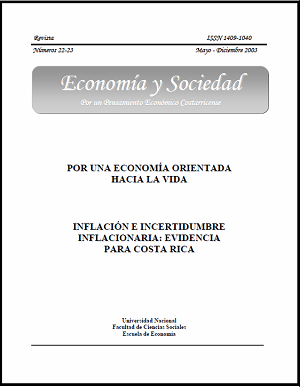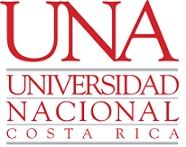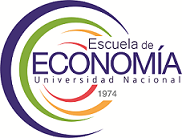FLUJOS INTERNACIONALES DE CAPITAL PRIVADO EN COSTA RICA
Keywords:
Flujos internacionales de capital, crisis financieras, Asia, Brasil, Argentina, sobreinversión.Abstract
Las crisis financieras sufridas por varios países de economías emergentes durante el segundo semestre de 1997, la crisis de Rusia en 1998, la crisis de Brasil de inicios de 1999 y la crisis de Argentina de finales del 2000, son las más recientes e importantes trastornos financieros que han puesto a prueba teorías ampliamente aceptadas de la economía internacional y que han servido para desarrollar nuevos enfoques financieros.
La esencia de muchas crisis financieras en un país cualquiera es una enorme y repentina salida de capitales motivada por elementos de desconfianza basada en hechos reales o ficticiamente especulativos. La crisis en Asia, por ejemplo, pudo ocurrir porque una parte substancial de la deuda internacional estaba estructurada a muy cortos plazos de vencimiento.
References
Altenburg, Tilman, Wolfgang Hein y Jurgen Weller. 1990. El desafío económico de Costa Rica: desarrollo agroindustrial autocentrado como alternativa. Maestría en Política Económica de la Universidad Nacional, Costa Rica e Instituto de Estudios Latinoamericanos de la Universidad de Berlín.
Chen, Zhaohui y Moshin S. Khan. 1997. Patterns of capital flows to emerging markets: a theoretical perspective. International Monetary Fund. WP/97/13.
Chan-Lau, Jorge y Zhauhui Chen. 1998. Financial crisis and credit crunch as a result of inefficient financial intermediation with reference to the Asian financial crisis. International Monetary Fund. WP/98/127.
Ministerio de Comercio Exterior. 1998. Estrategia Nacional de Atracción de Inversiones. San José, Costa Rica.
Fernández-Arias, Eduardo y Peter J. Montiel. 1995. The surge in capital inflows to developing countries: prospects and policy response. World Bank. WB/WP/1473
Flood, Robert P. y Nancy P. Marion. 1998a. Perspectives on the recent currency crisis literature. International Monetary Fund. WP/98/130. Washington D.C.
Flood, Robert P. y Nancy P. Marion. 1998b. Selffulfilling risk predictions: an application to speculative attacks. International Monetary Fund. WP/98/124. Washington D.C.
Flood, Robert P. y Nancy P. Marion. 1996. Policy implications of “second-generation” crisis models. International Monetary Fund. WP/97/16. Washington D.C.
Fondo Monetario Internacional. Mayo de 2001. Perspectivas de la Economía Mundial. Washington, DC. pag. 34 a 35
Fondo Monetario Internacional. Mayo de 2000. Perspectivas de la Economía Mundial. Washington, DC. pag. 51 y 76.
Ghosh, Atish R. y otros. 1998. Currency boardsThe ultimate fix? International Monetary Fund. WP/98/08.
Graciela Kaminsky y otros. 1997. Leading indicators of currency crises. International Monetary Fund. WP/97/79.
Goldfajn, Ilan y Poonam Gupta. 1999. Does monetary policy stabilize the exchange rate following a currency crisis? International Monetary Fund. WP/99/42.
Goldfajn, Ilan y Taimur Baig. 1998. Monetary policy in the aftermath of currency crises: the case of Asia. International Monetary Fund. WP/98/170
Goldfajn, Ilan y Rodrigo O. Valdes. 1997. Capital flows and the twin crises: the role of liquidity. International Monetary Fund. WP/97/87.
Hakkio, C.S. y M. Rush. 1989. “Market efficiency and cointegration: an application to the sterling and deutschemark exchange rates” Journal of International Money and Finance. 8, 75-88.
IMF. 1999. Annual Report of the Executive Board for the Financial Year ended April 30, 1998. Washington, D.C.
Johnston, R Barry y Natalia Tamirisa. 1998. Why do countries use capital controls? International Monetary Fund. WP/98/181.
Kaminsky, Graciela, Saul Lizondo y Carmen M. Reinhart. 1997. Leading indicators of currency crises. International Monetary Fund. WP/97/79.
Kaul Inge, Isabelle Grunberg y Marc Stern. 1999. Global Public Goods. Cooperation in the 21st century. Oxford University Press. Oxford.
Knight, Malcom y Fabio Scacciavillani. 1998. Current accounts: what is their relevance for economic policymaking? International Monetary Fund. WP/98/71.
Krugman; Paul R. 1979. “A model of balance of payment crises” en Journal of Money, Credit and Banking 11 (August): 311- 25.
Lopez-Mejia, Alejandro. 1999. Large capital flows: a survey of the causes, consequences, and policy responses. International Monetary Fund. WP/99/17.
Mc Callum, B. 1994. “Reconstruction of the uncovered interest parity relationship” Journal of Monetary Economics. 33, 105-32.
Monge González, Ricardo. 2000. Parque Industrial Zona Franca de Cartago. Coalición de Iniciativas para el Desarrollo. San José, Costa Rica.
Montiel, Peter J. 1993. Capital mobility in developing countries: some measurement issues and empirical estimates. World Bank. WB/WP/1103.
Montiel, Peter J. 1998. The Capital Inflow Problem. World Bank. EDI Working Papers.
Radelet and Sachs. 1999. What have we learned, so far, from the Asian financial crisis? HIID, Harvard University.
Sachs, Jeffrey. 1982. “The current account in the macroeconomic adjustment process” Scandinavian Journal of Economics, Vol. 84: 147-159.
Soros, George. 1998. The Crisis of Global Capitalism: open society endangered. Public Affairs. New York.
Tanner, Evan. 1998. Deviations from uncovered interest parity: a global guide to where the action is. International Monetary Fund. WP/98/117.
Downloads
Published
How to Cite
Issue
Section
License
This publication is subject to the Creative Commons License; therefore, its attributions and restrictions must be respected.
Authors publishing in this Journal accept the following conditions:
- Authors retain copyright ownership and give the Journal first publication right of the paper, which is registered with the Creative Commons Attribution-NonCommercial-ShareAlike 4.0 International License. This license allows third parties to use the published work provided it is sourced as firstly published in this Journal.
- Authors may enter into other independent and additional contractual agreements for the non-exclusive distribution of the article published in this Journal (e.g., to be included in an institutional repository or published in a book) provided it is clearly stated that the work was published in this Journal for the first time.
- Authors are allowed and recommended to publish their work on the Internet (for example, on institutional or personal pages) before and during the review and publication process, as it can lead to productive exchanges and a greater and faster dissemination of work published.

The Economía & Sociedad Journal, published by Universidad Nacional, is licensed under a Creative Commons Reconocimiento-NoComercial-CompartirIgual 4.0 Internacional License. Based on http://www.revistas.una.ac.cr/index.php/economia.








